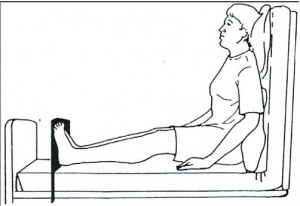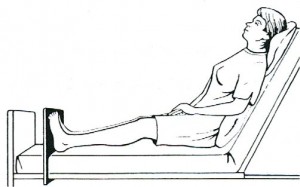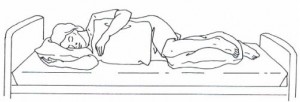Placing the Adult Patient in the Supine Position (see figure 4-2).
Collect equipment.
- Pillows.
- Positioning aids as indicated.

Wash your hands.
Approach and identify the patient (by checking the identification band) and explain the procedure (using simple terms and pointing out the benefits).
Provide privacy throughout the procedure.
Position the bed.
- Place the bed in a flat or level position at working height, unless contraindicated.
- Lower the side rails on the proximal side (as necessary).
Move the patient from a lateral (side) position to a supine position.
- For the patient on his side, remove supportive pillows.
- Fold top bedding back to the hips, being careful to avoid any undue exposure of the patient’s body.
- With one hand on the patient’s shoulder and one on the hip, roll his body in one piece (like a log) over onto his back.
Align the patient’s body in good position.
- Head, neck, and spine are in a straight line.
- Arms are at the patient’s sides (parallel to the body) with hands prone.
- Legs are parallel to his body.
- Hips, knees, and feet should be in good alignment.
Support the body parts in good alignment for comfort.
- Place a pillow under the head and shoulders to prevent strain on neck muscles and hyperextension and flexion of the neck.
- Support the small of the back with a folded bath towel or small pillow.
- Put a footboard at the foot of the bed and place the feet flat against it (at right angles to the legs) to prevent plantar flexion (“foot drop”).
- Arrange a sandbag along the outer portion of the right foot to keep the foot upright.
- Make a trochanter roll and arrange it along the right hip and thigh to keep the hip joint from rotating outward.
- Place a pillow under each forearm so the arm is at least six inches from the body.
Provide for the patient’s comfort and safety.
- Replace the bedding neatly and raise the side rails, if used.
- Place the call light within reach.
- Position the bedside stand or overbed table so that the patient will be within easy reach of drinking water and personal items.
- Leave the bed in the low position.
Report significant nursing observations to the charge nurse.
Placing the Adult Patient in the Fowler’s and Semi-Fowler’s Position (see figures 4-5 and 4-6).


Collect equipment.
- Pillows.
- Positioning aids as indicated.
Wash your hands.
Approach and identify the patient (checking the ID band) and explain the procedure (in simple terms and pointing out benefits).
Provide for privacy throughout the procedure.
Be sure the patient is in a supine position with his head near the top of the bed.
Elevate the head of the bed.
- Elevate 60 to 90 degrees for the Fowler’s position.
- Elevate 45 to 60 degrees for the semi-Fowler’s position.
Raise the knee gatch (knee rest) of the bed approximately 15 degrees unless contraindicated.
Use a footboard to maintain the feet at right angles to the legs.
Use pillows for support as needed.
- Behind the shoulders and head to prevent flexion and hyperextension of the neck.
- Behind the lower back to prevent posterior convexity of the lumbar spine region.
- Under the thighs to prevent hyperextension of the knees.
Place the patient in good body alignment.
- Head, neck, and back are straight.
- The weight of the body is supported where the hips are flexed in the sitting position.
- Feet are straight.
- Toes are pointing up.
Provide for the patient’s comfort and safety.
- Replace bedding neatly.
- Raise and secure the side rails.
- Place the call light within reach.
- Position the bedside stand or overbed table so that the patient will be within easy reach of drinking water and personal items.
- Leave the bed in a low position.
Report significant nursing observations to the charge nurse.
Prone Position (see figure 4-1).

Collect the equipment.
- Pillows.
- Positioning aids as indicated.
Wash your hands.
Approach and identify the patient and explain the procedure.
Provide for privacy.
Adjust the bed.
- Lower the headrest and knee rest so that the bed is in a flat position.
- Raise the bed to working height.
- Lower the side rails on the side where you are working.
- Fold the top bedding down to the level of the patient’s hips, but avoid undue exposure of the patient’s body, which may cause embarrassment.
Position the patient in bed.
- If there is room between the end of the mattress and the foot of the bed, the patient should be moved down in the bed so that his feet extend over the edge of the mattress.
- Remove the footboard if one is present.
Turn the patient onto his side and then onto his stomach.
- Roll toward you so you can observe him closely.
- Continue to roll until he is on his stomach.
Align the patient in good position.
- Head is turned to one side.
- Neck and back are in a straight line.
- Arms are parallel to the body in a slightly flexed position; or arm on the same side toward which the head is turned can be flexed sharply at the elbow so the hand is near the head.
- Legs are straight.
- Feet are extended over the edge of the mattress to avoid hyperextension of the foot; or a pillow is placed under both ankles to prevent plantar flexion (foot drop) as a result of prolonged hyperextension.
- Support the patient’s body and keep it in good alignment.
- A small pillow or folded towel under the head may be used to prevent hyperextension and flexion of the neck.
- A pillow under the abdomen provides comfort and prevents hyperextension of the lower spine.
- Provide for the patient’s comfort and safety.
- Replace bedding neatly.
- Raise and secure the side rails.
- Place the call light within reach.
- Position the bedside stand or over-the-bed table within reach so the patient can get drinking water and personal items.
- Leave the bed in a low position.
- Report significant nursing observations to the Charge Nurse.
Lateral (see figure 4-7) and Sim’s (see figure 4-3) Positions.


Collect equipment.
- Pillows.
- Positioning aids as indicated.
Wash hands.
Approach and identify the patient by checking identification band.
Explain the procedure and gain patient’s cooperation.
- Use simple terms.
- Point out benefits.
Provide for privacy.
- Position the bed.
- Lower head and foot of the bed so it is level or flat.
- Lower the side rails on the proximal side; the distal side rail must be up.
Turn the patient onto the side.
- Obtain assistance, if needed.
- Fold the top bedding back to the level of the patient’s hips, but avoid undue exposure of the patient’s body which may cause embarrassment.
- Flex the distal knee and place the distal arm across the chest.
- “Log-roll” the patient toward you by placing one hand on the shoulder and the other on the distal hip and pulling without twisting the patient’s torso.
- Reach behind the patient’s back with both hands, placing one on the proximal hip and lift slightly outward and roll the body toward yourself.
Alternative method: turn the patient onto the side away from self.
- “Log-roll” the patient’s body away from self by putting one hand on the proximal shoulder and the other on the hip and rolling the patient to the distal side.
- Lower hands to the distal shoulder and hip and pull them toward self to stabilize the patient in the lateral position.
Align the patient’s body in good position.
- Ensure the patient is not lying on his/her arm.
- Head, neck, and back are in a straight line.
- Legs are parallel with knees slightly flexed.
- Uppermost arm may be flexed across patient’s abdomen or supported on his/her body and hip.
Support the body in good alignment for comfort.
- Place a pillow under the patient’s head and neck to prevent muscle strain and maintain alignment.
- Put a pillow under the uppermost leg so that it is supported from the knee to the foot.
- Place another pillow firmly against the patient’s abdomen to support the back and hips in better alignment, if necessary.
- You may want to use a pillow to support the back.
- Place a pillow lengthwise along the back.
- Tuck one edge under the side.
- Roll the remainder of the pillow under (toward the bed surface).
- Tuck the pillow firmly against the back.
- You may also want to use a pillow to support the knee.
- Place a pillow between the knees.
- Bend the upper knee to provide stability.
Provide for the patient’s comfort and safety.
- Replace the bedding neatly.
- Raise and secure the side rails.
- Place the call light within reach.
- Position the bedside stand and over-the-bed table so that the patient is within easy reach of drinking water and personal items.
- Leave the bed in a low position.
Report significant nursing observations to the charge nurse.
